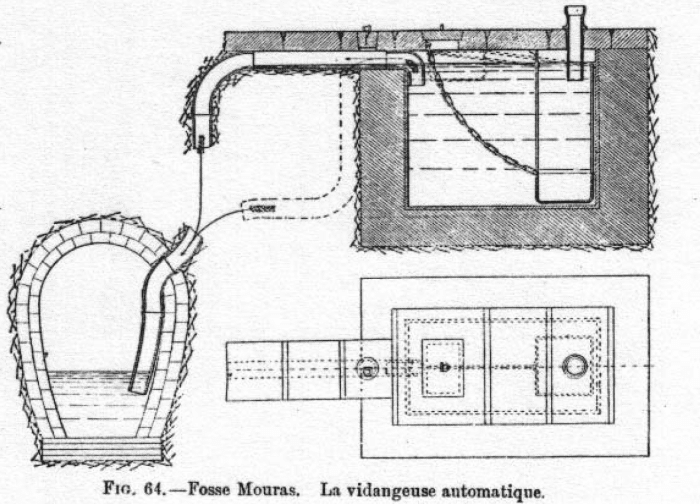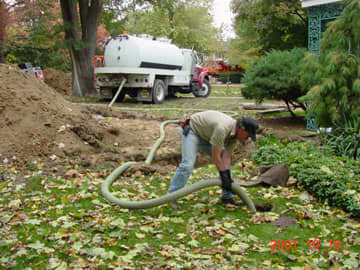What Do I Need To Treat My Sand Filter Septic System Went To Keep It Running Smoothly
Ashley represents an independent and locally owned professional person plumbing squad.
Looking for a new domicile is a daunting task in itself, but finding the perfect location only to realize information technology has a septic organization tin oftentimes crusade worry in buyers unfamiliar with them. Withal, this system isn't quite every bit complex or scary as it lets on. With a piffling sensation and merely a bit of regular intendance, this time-tested organisation will by and large have care of itself.

Septic systems have been around a long fourth dimension
How It Works
A typical septic system consists of two distinct parts: the septic tank and the drain field. The latter may also be referred to every bit leach or soil assimilation fields. The organisation uses a combination of nature and technology to treat wastewater from bathrooms, laundry and the kitchen sink. This also includes waste from the garbage disposal.
Once used, the h2o travels from the home to the septic tank through one principal drainage piping. The tank, which is normally made of concrete, fiberglass, or polyethylene, is buried underground where it holds the wastewater long enough to carve up. The solids settle downwardly to the bottom as sludge and the oil and grease float to the summit as scum. Compartments and a T-shaped outlet proceed these in the tank while the liquid wastewater, unremarkably referred to equally effluent, exits to the drain field.

Components of a septic system
The drain field is a shallow, covered earthworks made of unsaturated soil. Piping discharges the pretreated wastewater onto porous surfaces that let it to filter through the soil. The soil accepts, treats and disperses the water equally it percolates through the soil, naturally removing harmful coliform leaner, viruses and nutrients. In the end, it is discharged to groundwater.
The History of the Septic Organisation
Believe it or not, but the septic system has been around for more than than a century. The invention is credited to French engineer John Mouras, who created the first prototype effectually 1860. He used clay pipes to move wastewater from his home to a physical tank and, after ten years, dismantled the system to see if his theory that sewage was better stored before belch was accurate. To his surprise, it was nearly complimentary of solids with by and large liquid effluent. From this success, he obtained a patent in 1881 after finalizing the arrangement with the assistance of Abbé Moigno.
It wasn't until 2 years later that septic systems began appearing in America. The The states was very influential in development of off-mains drainage and were installing septic systems and drainage fields to a very high standard as early on as the 1920's. Nevertheless, they did non go popular until the 1940's when systems became cheaper during the post-WWII economical smash. Yet, these older systems began to fail in the 1960's and, x years later, many cities began regulating system sizing and design, forth with permitting new system installation, to ensure their integrity.

Today, septic systems, whether shared betwixt households or private, are used in a quarter of all households throughout the United states of america and many are all the same existence built with them. Near common in rural areas, particularly in New England and the Southeast, these homes are generally unable to connect to centralized sewer systems.
Maintaining a Septic Arrangement
Efficient H2o Usage Is Central
Efficient water usage is important in maintaining septic systems as all the water used in a habitation will end upwardly in the septic arrangement. Using loftier-efficiency toilets, faucet aerators and showerheads, selecting the proper load size for laundry, and promptly addressing leaky fixtures can reduce the volume of water entering the system, which reduces the adventure of failure.
Avoiding Excess Waste material Is Also Of import
Similarly, fugitive excessive waste disposal is essential. Never cascade cooking grease or oils, coffee grounds, photographic solutions or household chemicals like pesticides, antifreeze and paint thinners down the drains. Avoid flushing feminine hygiene products, paper towels, flushable wipes, diapers, condoms, dental floss, pharmaceuticals, cigarettes or cat litter. The septic arrangement contains organisms that digest and treat human waste matter and toilet paper, but these harmful items can kill them or otherwise cake and damage the entire system.
Scroll to Continue
Read More From Dengarden
Maintaining the Bleed Field
It'due south likewise important to be aware of the drain field. Never park or drive over the field. Ensure roof drains, sump pumps and other rainwater drainage systems are abroad from there as well equally excess water tin slow down or stop the h2o treatment process. When working on landscaping, constitute copse an appropriate distance from your drain field to proceed the roots from growing into the system. If needed, a septic service professional tin advise how far is an advisable distance based on the blazon of tank and landscape.
Regular Inspections Are Required
Septic systems do crave regular inspections, at least every iii years, by a service professional. The number of people in a household, water usage and tank size may also crave inspections over a shorter time frame. Additionally, it is important to exist aware of any alternative systems, such equally those with electrical float switches, pumps or mechanical components, as these should be inspected annually.
Pumping Every 3-five Years
Standard household septic tanks besides need to be pumped every iii to five years. This process cleans out the sludge at the bottom of the tank that does not break downwardly. While the cost of this process averages a few hundred dollars, it is essential to preclude sludge from backing up into the drain field or causing a tank failure, which can cost thousands to supercede.

Pumping out sludge is office of the maintenance
Environmental Concerns
While there take been several reports expressing concerns about the environmental impact of individual septic systems, most note that this threat is present almost exclusively when proper maintenance does non happen. Every bit long equally homeowners care for and apply this system correctly, they should concluding for decades.
However, the growing amount of systems may be more the environment can handle even with proper maintenance. In some areas, the human releases of nitrogen has disrupted the balance of naturally occurring nitrate. Soil usually absorbs very petty nitrate and the backlog moves into the h2o table through groundwater move and rainfall events. Nitrate in high concentrations is toxic to humans and can return a water source unfit for man use.

In some areas homo release of nitrogen has impacted the surroundings
This too risks aquatic ecosystems likewise. Elevated levels of nitrogen in waterbodies crusade algae blooms. Afterwards consuming the excess nitrates, the algae blooms die off and microorganisms feed on them which and so profoundly reduces the amount of dissolved oxygen in the h2o. When oxygen levels autumn below 30% saturation, the water becomes hypoxic and can no longer support fish or other aquatic species.
New engineering science is keeping pace with this and septic systems capable of reducing nitrogen are currently available for the environmentally conscious. Still, it is non yet required and therefore not used in nearly homes as information technology tin be expensive to put in place.

New technology can assist reduce ecology damage if needed
Signs a Septic System Is Failing
Even with the best maintenance, homeowners should be vigilant for any signs of failure.
- Smell: Some things to watch for include a sewage odor in the home, yard or bleed field.
- Green Grass: Greener grass around the septic tank site and wet basis or standing water in the drain field. The latter volition require immediate attention as these crusade a health hazard.
- Flushing Issues: In the home, listen for gurgling in the pipes and lookout for toilets refusing to affluent, which can bespeak that the tank is too total of solids and cannot work properly. This should too exist addressed promptly to avoid a redundancy of sewage.
Never hesitate to reach out to your local septic professional person with any questions or concerns about your septic organization.
This article is authentic and true to the best of the writer'south knowledge. Content is for informational or amusement purposes only and does non substitute for personal counsel or professional advice in business, financial, legal, or technical matters.
What Do I Need To Treat My Sand Filter Septic System Went To Keep It Running Smoothly,
Source: https://dengarden.com/home-improvement/All-About-Septic-Systems
Posted by: gurleygracts1948.blogspot.com


0 Response to "What Do I Need To Treat My Sand Filter Septic System Went To Keep It Running Smoothly"
Post a Comment